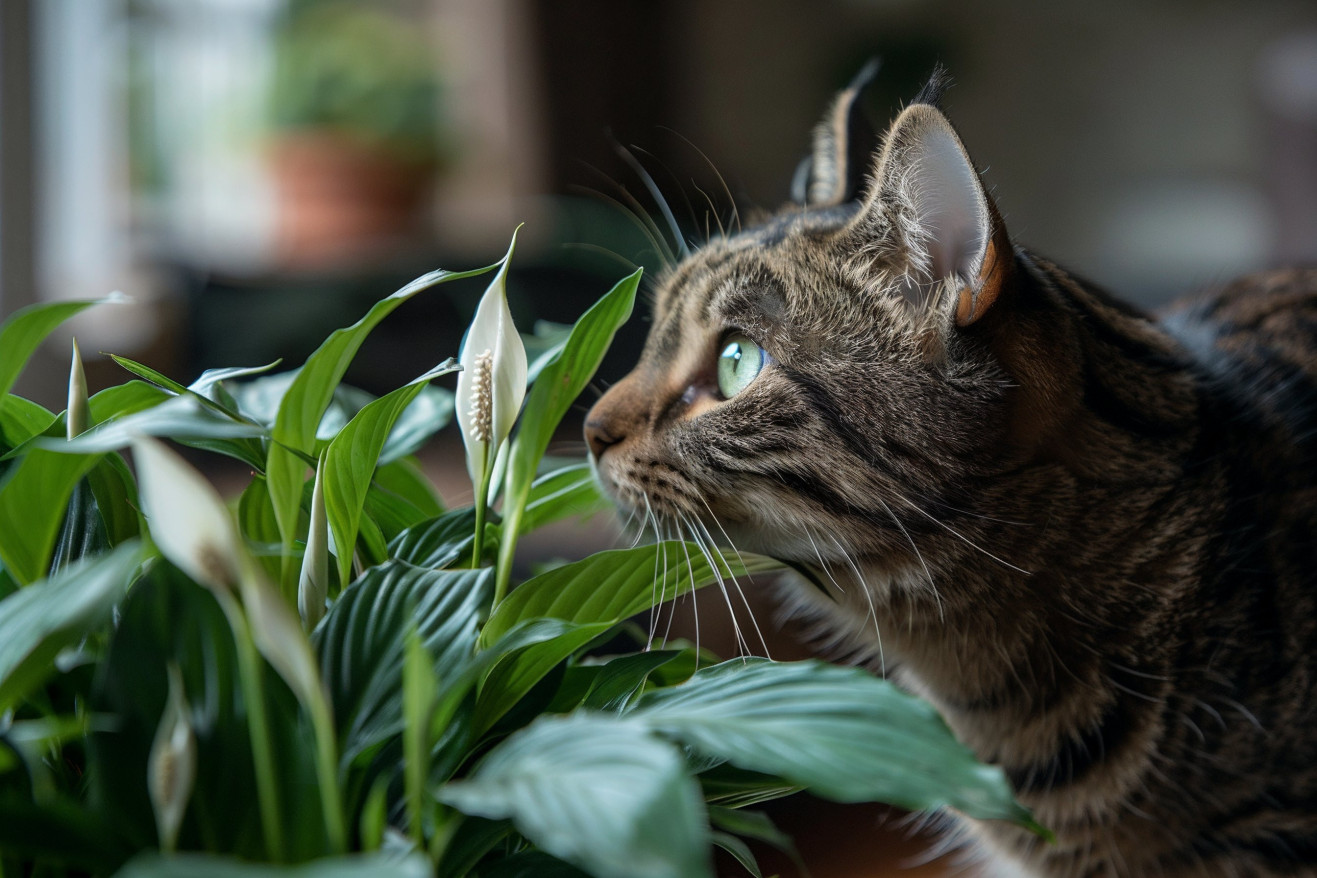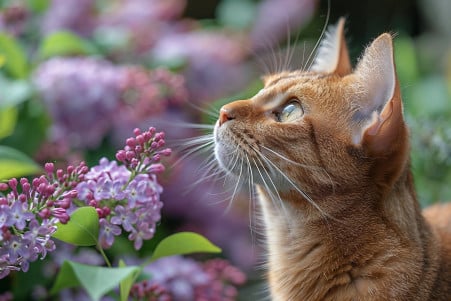Do Peace Lilies Hurt Cats? Everything You Need to Know
16 May 2024 • Updated 15 May 2024

To better understand how much harm they can cause and what to look out for, it's important to know the basics of how peace lilies can affect cats. Peace lilies are considered only mildly toxic to cats, and if eaten, they can cause symptoms such as vomiting, drooling, and difficulty swallowing. This is because the insoluble calcium oxalates in peace lilies can cause irritation to the mouth, tongue, throat, and stomach.
It's best to keep peace lilies away from cats and offer them other plants that are nontoxic. That said, the relationship between peace lilies and cats is nuanced, and there are steps you can take to protect your cat. In this article, we'll explore the scientific evidence behind the toxic compounds in peace lilies, detail the symptoms cats may experience if they eat peace lilies, and share insights from veterinarians about how to prevent and address peace lily toxicity. This well-rounded view will help you better understand how to ensure your cats' safety when it comes to these common indoor plants.
Are peace lilies poisonous to cats?
What Makes Them Toxic: Calcium Oxalate Crystals in Peace Lilies
Peace lilies have sharp, needle-shaped calcium oxalate crystals in the leaves, stems, and flowers, reports the Animal Poisons Helpline. These crystals are insoluble and can cause an immediate burning sensation when they come into contact with the mouth and tongue. According to the FDA, the crystals are a direct irritant to the mouth, tongue, throat, and esophagus, which results in clinical signs such as pawing at the face, drooling, foaming, vocalizing, vomiting, and diarrhea.
The crystals are an irritant that causes damage to the mouth, tongue, throat, and gastrointestinal lining, says Poison Control. While the clinical signs are generally self-limiting, the reaction can be more severe based on the amount of plant material ingested and the individual cat's reaction to the toxin. While peace lilies aren't as dangerous as true lilies, cats should still be kept away from them due to the potential for pain, inflammation, and gastrointestinal upset caused by the oxalate crystals.
Signs of Peace Lily Poisoning in Cats
According to Mauna Loa Peace Lily Poisoning in Cats - Symptoms, Causes, Diagnosis, Treatment, Recovery, Management, Cost, some of the most common signs of peace lily poisoning in cats include drooling, vomiting, and loss of appetite. Cats may also have oral pain, swelling, and difficulty swallowing as a result of the irritation caused by the calcium oxalate crystals in the plant.
In more serious cases, the Gardening Know How says that the swelling can even reach the upper airway, which can cause breathing problems and respiratory distress. Signs of peace lily poisoning will typically develop soon after the plant is ingested and can vary in severity based on the amount that was eaten.
It’s important to seek veterinary care right away since, according to PetMD, complications like dehydration and secondary infections can arise. Knowing what to look for can help cat owners get their pets the help they need as soon as possible to minimize the risk of additional discomfort or danger.
First Aid and Veterinary Treatment for Peace Lily Ingestion
If you suspect that your cat has ingested a peace lily, it is important to contact a veterinarian immediately, according to lovethatleaf. Do not try to make your cat vomit unless your vet tells you to do so, as this can make the situation worse.
Treatment may include stabilizing the cat, rinsing the mouth, and giving antihistamines or other medications to help with symptoms, according to WagWalking. In more serious cases, the cat may need to be hospitalized and given IV fluids and other treatments to help with potential side effects.
Most cats will make a full recovery within 1-2 weeks with treatment, but it is important to act quickly to avoid further distress or complications, according to Gardening Know How. By knowing the right first aid and medical treatments, cat owners can help their pets get through an incident of peace lily ingestion.
Protecting Cats: How to Avoid Peace Lily Toxicity
The most effective way to prevent peace lily toxicity in cats is to keep the plants out of their reach or to get rid of them altogether, says Is a Peace Lily Toxic to Cats or Dogs: A Pet Owners' Guide. If you do decide to keep peace lilies in your home, the article suggests placing them in high or hard-to-reach places and using barriers or other methods to keep pets away.
To help cats explore their environment in a safe way, the Cat-Safe Houseplants: 20 Plants to Fill a Plant-Friendly Home article recommends offering cat-friendly plants like spider plants, Boston ferns, or air plants. You can also protect the soil in your plants by covering it with rocks or other materials to prevent cats from digging or investigating.
In addition, it's important to keep a close eye on cats when they're near peace lilies and to offer them other outlets for scratching and chewing, says the 26 Indoor Plants Safe for Cats and Dogs article. These measures will help ensure that cat owners can enjoy peace lilies without having to worry about their cats' safety.
Alternatives to Toxic Plants
For cat owners who still want to bring some greenery into their homes, there are plenty of non-toxic options that are safe for cats, according to Cat Friendly Plants — You can Love both Houseplants and Cats!. Some of the most popular cat-friendly plants include spider plants, Boston ferns, African violets, and succulents like jade and echeveria. In addition, rosemary, thyme, and mint are all safe herbs that can be grown indoors.
When choosing plants, the 26 Indoor Plants Safe for Cats and Dogs list recommends always checking the toxicity of any plant you’re considering and cross-referencing it with the ASPCA's list of non-toxic plants. Even non-toxic plants can cause stomach upset if a cat eats enough of them, so it’s important to make sure you’re still taking care of your plants and monitoring your cat’s behavior around them, as noted in 10 Toxic Houseplants Pet Owners Should Avoid.
However, by choosing cat-friendly plants and taking the necessary precautions, you can enjoy the benefits of houseplants while ensuring that your cat stays safe and healthy.
Conclusion: How to Protect Your Cat From Peace Lilies
Peace lilies are one of the most popular indoor plants, and for good reason. They are beautiful and easy to care for. However, they can be dangerous to cats who are curious and like to nibble on plants. Although they are not as toxic as true lilies, peace lilies contain calcium oxalate crystals, which can cause oral and gastrointestinal issues in cats. Catster notes that these crystals can cause symptoms such as excessive drooling, mouth swelling, and constant rubbing of the face.
If a cat does eat a peace lily, it's important to get them to the vet as soon as possible. The vet can provide pain relief and determine the best way to treat the cat. FloRaSense says that pet owners should look out for symptoms of poisoning, including vomiting, lethargy, and changes in behavior. In some cases, cats may need to be hospitalized so that they can receive supportive care.
To ensure that cats are safe, peace lilies should be removed from the home or kept in a place where cats can't get to them. Lawn.com.au recommends using physical barriers, repellents, and providing cats with cat grass to keep them from being interested in peace lilies. By taking these steps, cat owners can enjoy peace lilies while ensuring that their cats are safe.


